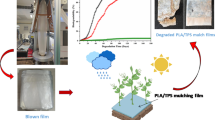Abstract
The present work focuses on the study of the physical characteristics of olive stone wooden residues at the prospect of its use as a bulking material in compost process. The physical characteristics that were studied according to particle mesh classification, were the apparent density, porosity, water holding capacity, air free space and air pressure drop. From the experimental results, it was proved that only the fraction of 6.8–12.5 mesh, which is 29.40% of the substrate, could maintain the moisture in the optimum range 40–60%. The fraction of the particles of 2.6–23.6 mesh, which was 74.68% of the substrate, had appropriate porosity for composting. It was also proved that for dried substrate and air velocity 300 m h−1, acceptable pressure drop (10 cm H2O m−1) was observed for the fraction of the particles of 2.6–27.5 mesh, which was 80.08% of the substrate, while for dried substrate and air velocity 150 m h−1, the respective fraction was particles of 2.6–37.9 mesh which accounted for the 89.48% of the substrate. Conclusively, olive oil processing solid residues have the physical characteristics, so as to be used for composting or as a substrate for co-composting with high strength wastewater.









Similar content being viewed by others
References
Bouranis D, Vlyssides A, Drossopoulos J, Karvouni G (1995) Some characteristics of a new organic soil conditioner from the co-composting of olive oil processing wastewater and solid residue. Commun Soil Sci Plan 26(1&16):2461–2472
Finstein M, Miller F, MacGregor S, Psarianos K (1985) The rutgers strategy: composting process design and control. EPA/600/2–85/059. Obtainable from U.S. Dept. Commerce, National Technical Information Service, Springfield, VA 22161. (Accession No PB85 207538/AS)
Grabbe K (1988) Definition of compost-quality–a need of environmental protection. In: Compost processes in waste Management, Proceedings of Workshop, Monastery of Neresheim, 1988
Griffin D (1981) Water potential as a selective factor in the microbial ecology of soils. In: Parr JF, Gardner WR, Elliott LF (eds) Water potential relations in soil microbiology, Soil Society of America, Wisconsin
Hamoda M, Abu Qdais H, Newham J (1998) Evaluation of municipal solid waste composting kinetics. Resour Conserv Recy 23(4):209–223
Haug T (1979) Engineering principles of sludge composting. J Water Pollut Control Fed 51(8):2189–2206
Haug T (1980) Compost engineering, principles and practice. Technomic Publishing Co Inc, Lancaster
MacGregor S, Miller C, Psarianos K, Finstein M (1981) Composting process control based on interaction between microbial heat output and temperature. Appl Environ Microb 41(6):1321–1330
Madejón E, Díaz M, López R, Cabrera F (2002) New approaches to establish optimum moisture content for compostable materials. Bioresource Technol 85(1):73–78
Manios B (1979) Investigation for a soil conditioner production from the olive oil processing solid residues. PhD Thesis, Agricultural University of Athens
Manios T, Maniadakis K, Boutzakis P, Naziridis Y, Lasaridi K, Markakis G, Stentiford E (2006) Methane and carbon dioxide emission in a two-phase olive oil mill sludge windrow pile during composting. Waste Manage (in press) doi:10.1016/j.wasman.2006.05.012
Mohee R, Mudhoo A (2005) Analysis of the physical properties of an in-vessel composting matrix. Powder Technol 155(1):92–99
Molla A, Fakhru’l-Razi A, Alam Z (2004) Evaluation of solid-state bioconversion of domestic wastewater sludge as a promising environmental-friendly disposal technique. Water Res 38(19):4143–4152
Pollak R (1979) Selecting fans and blowers. In: The Staff of Chemical Engineering (eds) Fluid movers, McGraw-Hill Publications Co, New York
Schulze K (1962) Continuous thermophilic composting. Appl Microb 10:108–122
Suler J, Finstein M (1977) Effect of temperature, aeration, and moisture on CO2 formation in bench-scale, continuously thermophilic composting of solid waste. Appl Environ Microb 33(2):345–350
Taralas G, Kontominas M (2006) Pyrolysis of solid residues commencing from the olive oil food industry for potential hydrogen production. J Anal Appl Pyrol 76(1–2):109–116
Thostrup P (1988) Evaluation of composting systems-concerning engineering, environment and economy. In: Compost processes in waste management, Proceedings of Workshop, Monastery of Neresheim, 1988
Tsikalas E (1985) Enrichment olive oil processing solid residues with nutrients for using as a soil. PhD Thesis, Agricultural University of Athens
Vlyssides A, Bouranis D, Loizidou M, Karvouni G (1996) Study of a demonstration plant for the co-composting of olive-oil-processing wastewater and solid residue. Bioresource Technol 56(2&3):187–193
Vlyssides A, Loizidou M, Zorpas A (1999) Characteristics of solid residues from olive oil processing as bulking material for co-composting with industrial wastewaters. J Environ Sci Health Part A A34(3):737–748
Willson G, Parr J, Epstein E, Marsh P, Chaney R, Colacicco D, Burge W, Sikora L, Tester C, Hornick S (1980) Mannual for composting sewage sludge by the Beltsville Aerated Pile Method. U.S. Dept. Agric./U.S. EPA, EPA-600/8–80–022, Cincinnati, Ohio
Author information
Authors and Affiliations
Corresponding author
Rights and permissions
About this article
Cite this article
Vlyssides, A.G., Barampouti, E.M.P. & Mai, S.T. Physical characteristics of olive stone wooden residues: possible bulking material for composting process. Biodegradation 19, 209–214 (2008). https://doi.org/10.1007/s10532-007-9127-5
Received:
Accepted:
Published:
Issue Date:
DOI: https://doi.org/10.1007/s10532-007-9127-5




